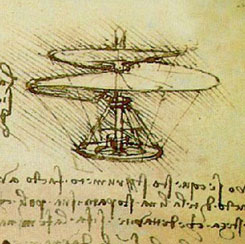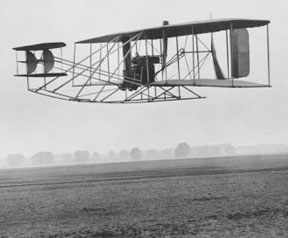Helicopters & Autogyros
Early thinking

Helicopter flight was probably the first type of flight envisioned by man. The idea dates back to ancient China, where children played with homemade tops of slightly twisted feathers attached to the end of a stick. They would rapidly spin the stick between their hands to generate lift and then release the top into free flight.
In the Western world, the ancient Greek mathematician, physicist, and inventor, Archimedes, who lived and worked in the second century BCE perfected the principle of the rotating screw for use as a water pump. When the screw was rotated inside a cylinder, the screw moved the water in front of it. At the same time, the water resisted and pushed back. This resistance also applied to the movement of screws through air.
The 15th century Italian, Leonardo da Vinci has often been cited as the first person who conceived the idea of a helicopter capable of lifting a person and then experimented with models of his designs. His sketch of the "aerial-screw" or "air gyroscope" showed a device with a helical rotor. The helical surface on his device resembled a helicopter and was made from iron wire and covered with linen surfaces made "airtight with starch."
The first autogyro

Juan de la Cierva, a Spanish engineer and aeronautical enthusiast, invented the first successful rotorcraft, which he named autogiro in 1923. His aim was to create an aircraft which would not stall. His craft used a tractor-mounted forward propeller and engine, a rotor mounted on a mast, and a horizontal and vertical stabilizer.
They were the first rotary wing aircraft to fly successfully with sufficient control. The design had inherent safety, better low-speed flight than airplanes, as well as the capability of vertical take-off and landing. But despite their advantages, even before the introduction of the first successful helicopters which surpassed their performance, autogyros were never accepted.
They were never accepted because although they had a higher speed envelope than airplanes, it had a higher drag and so were not as efficient at higher speeds, and absolutely could not attain the maximum speeds of the faster airplanes. Also, the early autogyros did not have the vertical takeoff and landing capabilities that would have made them more attractive to potential buyers.
The first helicopter

At the end of the nineteenth century, the internal combustion engine became available, making the development of full-sized vertical-flight craft with adequate power a possibility. However, other problems remained, particularly those relating to torque, dissymmetry of lift, and control. Inventors during the next two decades built many small prototype helicopters that attempted to solve these problems, but progress came only in small steps.
A flight of the first fully controllable helicopter was demonstrated by Raúl Pateras de Pescara 1916 in Buenos Aires, Argentina. In 1931, Soviet aeronautical engineers Boris Yuriev and Alexei Cheremukhin began experiments with the TsAGI 1-EA helicopter, the earliest known single lifting rotor helicopter, which managed to attain an altitude of 605 m (1,984 ft) on August 14, 1932 with Cheremukhin at the controls.
The availability of lightweight turboshaft engines in the second half of the 20th century led to the development of larger, faster, and higher performance helicopters. Turboshaft engines are the preferred powerplant for all but the smallest and least expensive helicopters today.